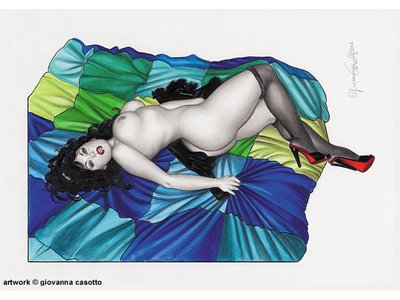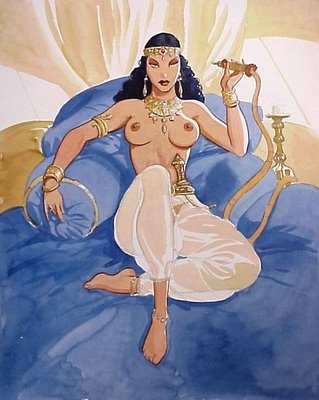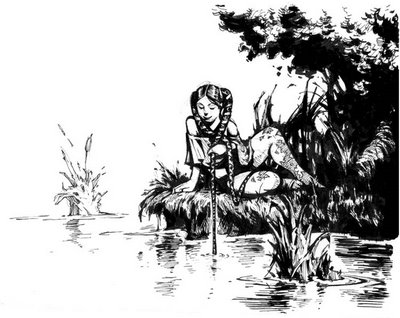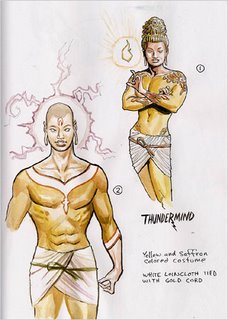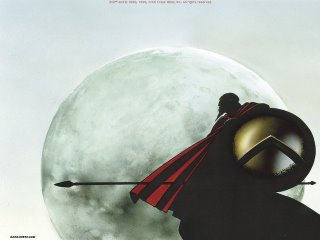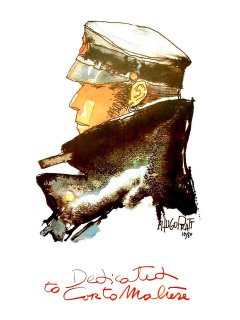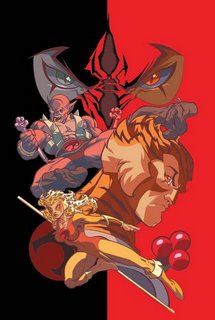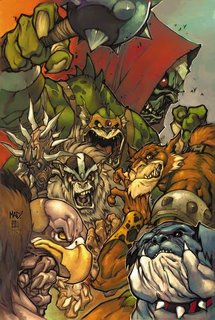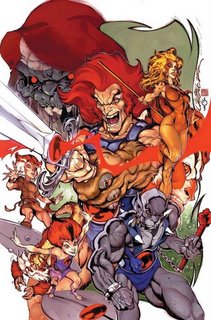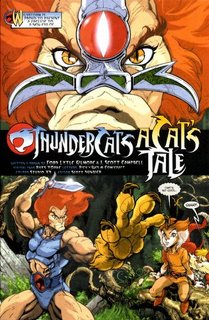21/11/06
30/9/06
Η 9η ΤΕΧΝΗ...

Από τις 12 έως 15 Oκτωβρίου θα πραγματοποιηθεί το 11ο Διεθνές Φεστιβάλ Κόμικς της Βαβέλ.
Οι φετινές εκδηλώσεις έχουν το κεντρικό θέμα Όνειρο ίσως, πάνω στο οποίο οι καλλιτέχνες που συμμετέχουν καλούνται να παρουσιάσουν ολοκληρωμένες ιστορίες.
Το κοινό θα έχει την ευκαιρία να δει από κοντά τις δημιουργίες γνωστών Ελλήνων σχεδιαστών (Δερβενιώτης, Ναβροζίδου, Πεχλιβανίδης, Solup, Μπότσος, Ζαφειράτος, Κυριαζής κ.ά.), τις εικαστικές επεμβάσεις του Σπύρου Βερύκιου και Λάζαρου Ζήκου, αλλά και καινούργιες προτάσεις από τους νέους εικαστικούς καλλιτέχνες Ανδρέα Κασάπη και Λάζαρο Ζήκο.
Παράλληλα, η ομάδα Carpe Diem ετοίμασε ένα ειδικό γκράφιτι γύρω από όνειρα, ενώ το ξεχωριστό τους στίγμα θα δώσουν και ξένοι δημιουργοί.
Με ιδιαίτερο ενδιαφέρον αναμένεται η έκθεση της μακροβιότερης ομάδας των Τσέχων υπερ-ρεαλιστών που δημιουργήθηκε το 1934 και παραμένει ενεργή μέχρι σήμερα, ενώ η έκπληξη έρχεται από την έκθεση με τράπουλες ταρό, σχεδιασμένες από σύγχρονους δημιουργούς.
Όπως αναφέρουν τα Νέα, θα παρουσιαστούν ακόμη τα πρωτότυπα των σειρών Ταρό του Δάντη, Ταρό μάνγκα, Ταρό βαμπίρ, Ταρό της Ατλαντίδας, ενώ χώρο στο Φεστιβάλ της Βαβέλ έχουν και οι αφίσες.
Τέλος, όπως κάθε χρόνο, η Τεχνόπολη θα γεμίσει από μουσικές, δρώμενα, θέατρο δρόμου και προβολές κινουμένων σχεδίων.
news.in.gr
(Brexians lair)
by
brexians
στις
17:31
0
of you said:
![]()
16/9/06
Donald Duck 72 years old
One of the most popular of the Disney cartoon characters, Donald Duck made his debut in the Silly Symphony cartoon "The Wise Little Hen" on June 9, 1934.
His fiery temper endeared him to audiences, and in the 1940s he surpassed Mickey Mouse in the number of cartoons reaching the theaters.
Eventually, there were 128 Donald Duck cartoons, but he also appeared in a number of others with Mickey Mouse, Goofy, and Pluto. His middle name, shown in a wartime cartoon, is Fauntleroy.
The original voice of Donald was Clarence "Ducky" Nash, who was succeeded after 50 years by Disney artist Tony Anselmo.
A daily Donald Duck newspaper comic strip began on February 7, 1938.
Donald Duck has a good heart and always has good intentions. Well, almost always. Actually, it's his second or third intentions that are the good ones, but by the time they surface Donald's already off and running in the wrong direction. He refuses to let anyone or anything stand in his way. It doesn't matter how much humiliation the world dishes out to him, Donald will take it and come back for more.
He's a loser, not a quitter, and he'll go down fighting. This is a duck with one short fuse, and an amazing (if unintelligible) command of language, and when things don't go right, he goes ballistic. Yet after the storm is over and the tantrum is through, when faithful Daisy soothes his brow or his conscience finally catches up with him, even Donald can admit that there must be a better way. If only he could figure out what it is.Hot-headed Donald is a little man in a big world that's trying to keep him down. Call it fate, or call it lack of self-control, nothing goes right for this duck: even his best intentions often go awry.
Of course, by the time his best intentions surface he's probably already chasing after less noble pursuits. As stubborn as he is temperamental, he won't give in, even when he's up to his beak in trouble. Then watch out. Like a lot of people with a temper problem, he's blind to his own faults but quick to see them in others. He can't understand why life seems so much easier for pals Mickey and easy-going Goofy.It's not fair. Still, Donald will keep struggling to get what he deserves in the world.
Favorite sayings:
"Oh, yeah?"
"Hiya, toots!"
"Aw, phooey!"
"Oh boy, oh boy, oh boy!"
"Nothin' to it!"
(Brexians lair)
by
brexians
στις
02:52
0
of you said:
![]()
8/9/06
22/8/06
Virgin Comics all set to foray into India
(Brexians lair)
by
brexians
στις
01:23
0
of you said:
![]()
15/8/06
Μολών Λαβέ
Go tell the Spartans, stranger passing by,
that here, obedient to their laws, we lie

In the Battle of Thermopylae of 480 BC an alliance of Greek city-states fought the invading Persian army in the mountain pass, Thermopylae.
Vastly outnumbered, the Greeks held back the Persian advance for seven days.
Leonidas, the Spartan King commanding the army, held up the enemy in one of the most famous last stands of history.
The resistance of the Spartan-led army offered Athens the invaluable opportunity to make battle preparations and decisively defeat the Persians at the battles of Salamis.
The final blow was delivered at Plataea, ending the Persian invasion of Greece and marking the rise of the Athenian Empire as a political and cultural world power.
The performance of the defenders at the battle of Thermopylae is
often used as an example of the advantages of training, equipment and good use
of terrain to maximise an army's potential, as well as a symbol of courage
against extremely overwhelming odds.
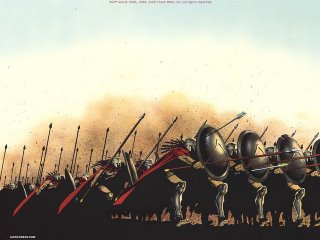
Let honor be to those in whose life
it was set to guard Thermopylae.
Never moving away from duty;
Just and equals in all of their acts
But with sadness and compassion
Brave once they are rich and when
They are poor, again brave
Coming to aid as much as they can;
Always speaking the truth
But without hate for those who lie.
And even more honor they deserve
When its predicted (and many predict)
That Ephialtes will appear in the end
And the Medes will finally pass through
Konstandinos Kavafis
Earth! render back from out thy breast
A remnant of our Spartan dead!
Of the three hundred grant but three,
To make a new Thermopylae!
Lord George Gordon Byron
may the force be with you
14/8/06
漫画, Manga
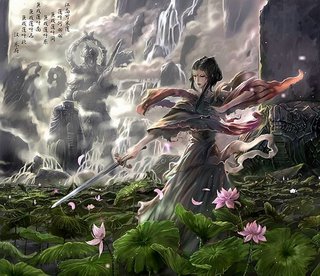
Manga is the Japanese word for comics and print cartoons. Outside of Japan, it usually refers specifically to Japanese comics. As of 2006, manga represents a $5 billion global market.
Manga developed from a mixture of ukiyo-e and foreign styles of drawing, and took its current form shortly after World War II.
It comes mainly in black and white, except for the covers and sometimes the first few pages, and in some Animanga all the pages are colored. Popular manga are often adapted into anime (Japanese for animation) once a market interest has been established. (Manga is sometimes mistakenly called "anime" even when not animated.)
Adapted stories are often modified to appeal to a more mainstream market. Although not as common, original anime is sometimes adapted into manga (such as Neon Genesis Evangelion and Cowboy Bebop).
History of manga
Literally translated, manga means "random (or whimsical) pictures". The word first came into common usage in the late 18th century—with the publication of such works as Suzuki Kankei's "Mankaku zuihitsu" (1771) and Santo Kyoden's picturebook "Shiji no yukikai" (1798)—and in the early 19th century with such works as Aikawa Minwa's "Manga hyakujo" (1814) and the celebrated Hokusai manga containing assorted drawings from the sketchbook of the famous ukiyo-e artist Hokusai.
However, gi-ga (literally "funny pictures", esp. tyō-jyū-jinbutu-gi-ga (鳥獣人物戯画), literally "funny pictures of animals and humans") drawn in the 12th century by various artists contain many manga-like qualities such as emphasis on story and simple, artistic lines.
Manga developed from a mixture of ukiyo-e and foreign art movements. When the United States began trading with Japan, Japan tried to modernize itself and catch up with the rest of the world.
Thus, they imported foreign artists to teach their students things such as line, form and color, which were never concentrated on in ukiyo-e as the idea behind the picture was normally considered more important.
Manga in this period was known as Ponchi-e (Punch-picture) and, like its British counterpart Punch magazine, mainly depicted humor and political satire in a short, 1- or 4-picture format.
by
brexians
στις
23:01
0
of you said:
![]()

Επεσε το πούσι αποβραδίς
-- το καραβοφάναρο χαμένο --
κ' έφτασες χωρίς να σε προσμένω
μές στην τιμονιέρα να με δείς.
Κάτασπρα φοράς κ' έχεις βραχεί,
πλέκω σαλαμάστρα τα μαλλιά σου.
Κάτου στα νερά του Port Pegassu
βρέχει πάντα τέτοιαν εποχή.Μας παραμονεύει ο θερμαστής
με τα δυό του πόδια στις καδένες.
Μην κοιτάς ποτέ σου τις αντένες
με την τρικυμία· θα ζαλιστείς.
Βλαστημά ο λοστρόμος τον καιρό
κ' είν' αλάργα τόσο η Τοκοπίλλα.
Από να φοβάμαι και να καρτερώ
κάλλιο περισκόπιο και τορπίλλα.
Φύγε! Εσέ σου πρέπει στέρεα γη.
Ηρθες να με δεις κι όμως δε μ' είδες
έχω απ' τα μεσάνυχτα πνιγεί
χίλια μίλια πέρ' απ' τις Εβρίδες.
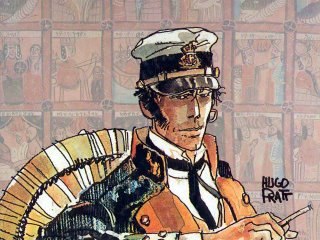

10/8/06
9/8/06
8/8/06
ALEX ROSS simply the best....

Looking back, it makes perfect sense that Alex Ross would become one of the world’s most pre-eminent and well-respected comic book artists. It’s a job he’s been preparing for nearly all his life. Born in Portland, Oregon, and raised in Lubbock, Texas, Alex made his artistic debut at three when, according to his mother, he grabbed a piece of paper and drew the contents of a television commercial he’d seen moments before.
Ross came from an artistic family: his mother was a commercial artist and his grandfather, he recalls, "built working wooden toys and loved drawing." When Ross discovered Spider-Man on an episode of The Electric Company, his life was changed forever. "I just fell in love with the notion that there were colorful characters like this, performing good, sometimes fantastic deeds," Ross says. "I guess I knew this was what I wanted to do. I wanted to bring these characters to life." Some cynics might confuse this attitude with escapism.
For Ross, it’s just the opposite. "It’s a fun environment to be in," he admits. "Superheroes are a mixture of every form of fiction – myth , science-fiction, mystery and magic – all in one giant pot. The best characters embody virtues we may try to find in ourselves." Ross is quick to credit his father Clark, a minister, with laying the moral framework that allowed him to appreciate the routinely good deeds performed by the likes of Superman and Spider-Man. "My dad has given aid -- physical aid, not just financial -- to a number of charities and causes. He’s helped at homeless shelters. He used to run a children’s shelter in Lubbock.
There was a positive effect to being around him, and his actions tied into what the superhero comics were teaching me. Superheroes aren’t heroes because they’re strong; they’re heroes because they perform acts that look beyond themselves." As he edged towards adulthood, Ross began reading comics and taking his draftsmanship seriously, admiring the work of comic book illustrators George Perez and Berni Wrightson in particular. "They were at opposite ends of the spectrum," Ross recalls. Wrightson, probably best known as the co-creator of Swamp Thing, "used a lot of delicate lines to delineate shadow and tone.
There weren’t a lot of comic book artists employing shadows back then. Perez, on the other hand, had a very attractive, open style with open contour lines and very little shadow. When I was 12, I would imitate Perez’s style when I drew superheroes and Wrightson’s style when I was doing ‘serious’ work. I realized there was no one way to go." This philosophy became especially true when Ross discovered such illustrators as Andrew Loomis and the great Norman Rockwell. "I idealized people like Rockwell, who drew in that photorealistic style," Ross says. "When I was 16 or so, I said to myself, ‘I want to see that in a comic book!’" Even as a young man, however, Ross knew "there was no satisfaction in basing my style upon the work of someone else." So, while his friends were exploring the uncharted territories of adolescence, Ross devoted his time to becoming a draftsman, with the long-term goal of making people believe a man could fly. "High school can be a chaotic time," he says. "Through my art and through what these characters represented, I found a sense of order that I wanted to apply to my life. It’s not that I wasn’t interested in dating or socializing. It’s just that part of me didn’t want to let go of the colorful characters I’d loved for so long."
At the age of 17, Ross went to Chicago and began studying painting at the American Academy of Art, the school where his mother had studied. "My time at the Academy was really valuable," he recalls. "I learned where I was as an artist and what kind of discipline I’d already learned. Here I was, drawing from a model for the first time and realizing I could represent the model. Not everyone in the class could do that. It was important to make that discovery." Studying at the Academy also allowed Ross to examine fine art in greater depth. "Salvador Dali wound up being a big influence, actually," he says. "He had a vivid imagination and a hyper-realistic quality that wasn’t so far removed from comic books. I began to study the classic American illustrators like Rockwell, J. C. Leyendecker… I’ve been called ‘The Norman Rockwell of comics’ more than a hundred times. I’m not going to suggest I’m on the same level as Rockwell, but attempting that sort of realism in my work has always been part of my approach." It was at the Academy that Ross hit on the idea of painting his own comic books. "There wasn’t any moment where I saw the light and said, ‘Painted comics! That’s the way!’" he recalls. "It was a by-product of my studies. There wasn’t any program that taught me to ink a comic book. There were programs that taught me to paint. I just naturally thought, ‘Well, of course I’m going to apply that to comics.’ There were also enough painted comics out there -- not a lot, but a few -- that made me think that talent could be applied."
There was also, Ross admits, a sense of wish fulfillment involved. "Hopefully by painting the work, you gain a sense of life and believability that will draw the reader in a little more. You can use color and light and shadow and live models to give the work a certain realism. It might be easier to relate to a character if you look at it and say, ‘Here’s an actor portraying someone. Here’s something that looks real.’ I thought it would draw people in and maybe add to their enjoyment of the work. There’s also a part of me that likes to speculate: ‘What if they made a movie about this character?’ I realize some of my favorite characters will never get the movie treatment, so it’s up to me to present them in a lifelike fashion, to make the movie that would otherwise never get made."
After three years at the American Academy, Ross graduated and took a job at an advertising agency. Meanwhile, Marvel Comics editor Kurt Busiek had seen Alex’s work and suggested the two men collaborate on a story. Those plans came to fruition in 1993 with Marvels, a graphic novel that took a realistic look at Marvel superheroes by presenting them from the point of view of an ordinary man. The book landed Ross his first serious media exposure, both within the industry and outside it. Fans appreciated that Ross had an obvious affection for the characters he painted, demonstrated by his attention to detail and the fact that he took the time to make these characters look so believable.
Ross followed up Marvels with Kingdom Come, a futuristic story for DC Comics about a minister who must intercede in a superhero Civil War. It was a visual feast, filled with surprise cameos, in-jokes and a main character based on Ross’ father, allowing Ross to publicly acknowledge his family’s influence. Having established himself creatively and financially with superhero projects, Ross turned to the real world with Uncle Sam, a 96-page story that took a hard look at the dark side of American history.
Like Marvels and Kingdom Come, the individual issues of Uncle Sam were collected into a single volume – first in hardcover, then in paperback – and remain in print today. Ross’ recent works have celebrated the 60th anniversaries of Superman, Batman, Captain Marvel and Wonder Woman with fully painted, tabloid-sized books, depicting each of these characters using their powers to inspire humanity as well as help them. "I do the gigs I do because I care about the material," he says. "In some cases, it’s because I like the character. In some cases, I have a vision in my head of something I must do. It all involves artistic expression. If I can’t get into the work on some artistic level, I can’t do it." In recent years, Ross has applied his artistic skills to outside projects with comic book roots, including a limited-edition promotional poster for the 2002 Academy Awards.
A number of items created especially for the Warner Bros. Studio Stores – including lithographs, collector’s plates and even a canvas painting of Superman – made him the best-selling artist in the chain’s history. In the fall of 2001, Ross painted a series of four interlocking covers for TV Guide (featuring characters from the WB series Smallville) and designed and sculpted a series of busts based on characters he created for the Marvel series Earth X. "Designing the statues," Ross explains, "was a case where I said, ‘Hey, I know I can do this, and before somebody else does it – maybe differently from the way I would like it done – I can sculpt some of the characters for which I’m well-known and make sure they look the way I want them to look.’
My comics work notwithstanding, I prefer not having to rely on the labors or plans of others. For the fans’ sake as well as for my own, I want to take full responsibility for the projects that bear my name." Forty years ago, Spider-Man learned that with great power comes great responsibility. Looking at Alex Ross, it’s obvious the lesson took. Ross’ career offers another important message: follow your dream. Actually, it’s not far from the sort of message you might find in one of his stories. 

may the force by with you
by
brexians
στις
23:40
0
of you said:
![]()

